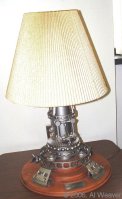
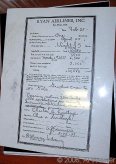
There was also a copy of the invoice for the Spirit of St. Louis.
Pratt & Whitney Museum Gas Turbines
by Al Weaver
Published 14 May 2017; Revised 3 Feb 2022
The Museum next door to the Customer Training Center started out as the original hangar in the 1920s. An administration building was added sometime later and of course the hangar grew in size to accommodate the United Technologies' corporate jet fleet. I used to fly out of there and, on cold days, always appreciated simply boarding the jets while they were still in the warm hangar, after which they would tow them outside for the engine start.
The experimental engines shown here were retired years ago and originally stored in a back corner of the experimental assembly floor. About once a year they were hauled out and dusted off for some kind of dignitary show. Eventually the number of engines increased and used up too much valuable room so they were shipped off to some warehouse where they were not seen for tens of years. Then somebody noticed that we were not only paying storage charges, but taxes on them as property as well. So it was time to scrap them. Luckily, somebody came up with the idea of declaring them museum pieces so they got hauled out of rental facilities and when UTC closed down their private airport, the old hangar became the "Museum" storage area. Unfortunately, this is not open to the public unless it’s for something like the Safety Fest.
Then there were some really interesting but highly classified engines in the 1950s. As a teenager I got myself into quite a bit of trouble with internal security when they found that I had taken some classified documents from the library and stored them in my locker. They were of what was known as the JT9 and the JT11, both of which looked like the JT12/J60 with afterburners but of a substantially larger size. The largest was the JT9 which I can’t recall if it ever got a military designation before the Air Force dropped the project and converted the JT11 over to the J58.
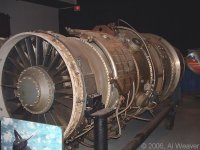 |
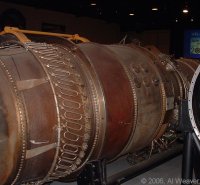 |
The experimental JT11 engine that grew into on the J58 for the Lockheed SR-71 |
I remember the highly classified J58/SR-71 project where even the shipment of the engines was secreted from the public eyes. We used to cover the engines up on a truck and ship them at night to an Air Force base. We didn’t use escorts at first since that alone might attract attention. But one day one of the truck drivers took a back road and ran the engine into a low railroad bridge, attracting all kinds of unwanted attention.
There was an engine project from which no parts have surfaced for viewing. I remember working on parts that had a giant afterburner that I could stand in without touching my head. At the same time there was what looked a burner section full of tubes that formed a heat exchanger. As a teenager I used to follow the manufacturing worksheets from department to department just to find out where the parts I was making finally ended up. Once again Internal Security became very suspicious of me and I later found out that they had the FBI investigate my high school years. I never could find out where that afterburner went. In later years I discovered test results for a small turbine that went with this project (much too small for such a large afterburner) that apparently connected to a large compressor via a gearbox. To this day I really don’t know what this was, but suspect that because of the heat exchanger it was part of the secret nuclear engine program.
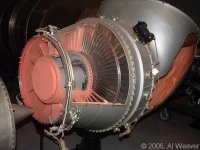 |
A free turbine was added to the back of a JT12 single spool engine. It was used on such things as the Sky Train helicopter, |
 |
 |
 |
 |
Some of the smaller Canadian-produced turboprops and Auxiliary Power Units (APUs). |
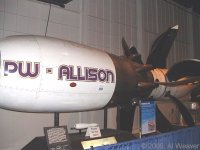 |
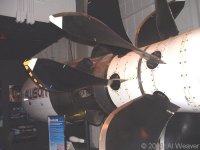 |
An experimental ultra high bypass project. |
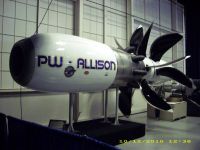 |
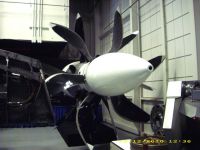 |
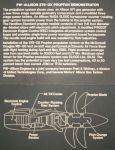 |
P&W-Allison Images by Mike Berch |
 |
 |
 |
 |
 |
 |
Just to add some class touches, here are a whole bunch of tailpipe views of afterburners. |
 |
 |
 |
Additional images by Mike Berch |
| P&W JT4/J75 | P&W XRJ40/RCJ-2 | P&W XRJ40/RCJ-2 |
Comments by Harold Craig
Al Weaver mentioned the 6-foot diameter afterburner and questioned where it was used. Based on Al’s description, the afterburner most likely belonged to one of the two 304 engines that were built under the SUNTAN program in the mid 1950s and run at the P&W Florida Research and Development Center (FRDC). At the time, the project was classified SECRET. Security was tight and poking around on that project was really discouraged. The 304 was a hydrogen-fueled afterburning jet engine. It essentially consisted of a fan feeding an afterburner. The fan was driven through a gearbox by a small diameter multi stage high speed turbine. The cycle took LH2, vaporized it in a heat exchanger in the afterburner, used the hot H2 to drive the turbine then exhausting hot gaseous H2 as fuel for the afterburner.
P&W built two experimental engines that successfully ran on liquid hydrogen. The engines were built to power a proposed high altitude reconnaissance airplane, a program was cancelled when Lockheed determined that an airframe couldn’t be designed to do the job. John Sloop of NASA, Dick Mulready of P&W and others have referred to this airframe/powerplant project in their books:
Sloop, John. Liquid Hydrogen as a Propulsion Fuel 1945-1959 (Washington, DC: Scientific and Technical Information Office, NASA, 1978). Also published as NASA SP4404, Liquid Hydrogen as a Propulsion Fuel 1945-1959 in 1977. This NASA history chronicles efforts to use LH2 including the P&W Suntan Project and the RL10 rocket engine.
Mulready, Dick Advanced Engine Development at Pratt & Whitney: The Inside Story of Eight Special Projects, 1946 - 1971 (Warrendale, PA: SAE, 2001).
At about the same time as the 304 engine, P&W also built two JT-9 engines, single spool afterburning jet engines, colloquially called the Walk-Thru-Engines because they were 6 feet in diameter. They ran successfully from the get-go. It is remotely possible that the afterburner to which Al refers belonged to the JT-9. No hardware airframe project used this engine although a couple of projects were rumored. Shortly later, the design of a scaled down version of this JT-9 engine, the JT-11 (J58) was initiated in East Hartford in the secure Foxmart facility, then the project was moved to FRDC for secure development. The JT-9 afterburning turbojet has no relationship whatever to the much more sophisticated JT-9D turbofan developed nearly a decade later.
Pratt & Whitney Museum Rare and Exotic Reciprocating Engines